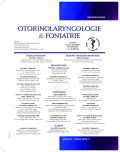Hearing Sreening of Five Years Old Children – A Prospective Study
Authors:
L. Školoudík 1; Viktor Chrobok 1
; M. Janouch 1; J. Vodička 2; Michal Černý 3
; Jan Mejzlík 1
Authors‘ workplace:
Klinika otorinolaryngologie a chirurgie hlavy a krku, Fakultní nemocnice Hradec Králové, Univerzita Karlova, Lékařská fakulta v Hradci Králové
1; Klinika otorinolaryngologie a chirurgie hlavy a krku, Nemocnice Pardubického kraje, Pardubická nemocnice, Fakulta zdravotnických studií Univerzity Pardubice
2; Ušní, nosní, krční ordinace, Chrudim
3
Published in:
Otorinolaryngol Foniatr, 67, 2018, No. 1, pp. 3-6.
Category:
Original Article
Overview
Introduction:
The prospective study reports on results of universal hearing screening of five years old children in Hradec Kralove and Pardubice regions.
Methods:
Children at the age of five underwent standard hearing screening by whispered voice test. Subsequently, children underwent ENT examination with pure tone audiogram. The whispered voice test sensitivity, specificity and kappa estimation agreement with pure tone audiometry were evaluated.
Results:
The study was carried out on 789 children. We proved hearing loss > 20 dB as a mean of four main frequencies in 9 %, bilaterally in 4 % of children. Conductive hearing loss was found out in 8 %, sensorineural in 1 % of five years old children. The whispered voice test had low sensitivity and specificity. In children with hearing loss > 20 dB the sensitivity was 60 %, specificity only 51 %. In case of hearing loss > 30dB the sensitivity increased to 65 %, specificity stayed on the level of 51%. The kappa estimation < 0.2 means pure agreement of pure tone audiogram with whispered voice test as well as patents hearing impairment survey.
Conclusion:
The incidence of hearing loss in preschool children and low efficacy of whispered voice test and patents hearing impairment survey advocate an audiometric hearing screening before beginning of school attendance.
Keywords:
hearing screening, audiometry, whispered voice test, five years old children
Sources
1. Bamford, J., Davis, A., Boyle, J. a kol.: Preschool hearing, speech, language, and vision screening. Qual Health Care, 7, 98, 4, s. 240-247.
2. Bamford, J., Fortnum, H., Bristow, K. a kol.: Current practice, accuracy, effectiveness and cost-effectiveness of the schoolentry hearingscreen. Health.Technol.Assess., 11(32), 2007, s. 1-168.
3. Černý, M., Zoban, P., Groh, D., Brabec, R., Vejvalka, J., Kabelka, Z., Vejvalková, Š., Vlk, R.: Screening sluchu u novorozenců pomocí transientně evokovaných otoakustických emisí, Čes.–slov. Pediatrie, 58, 2003, 11, s. 700-704.
4. Havlíková, E., Poláčková, R., Vítečková, T., Zeleník, K., Komínek, P.: Screening sluchu fyziologických a rizikových novorozenců metodami OAE a AABR – zhodnocení výsledků. Otorinolaryng. a Foniat. /Prague/, 64, 2015, 1, s. 17-21.
5. Chrobok, V., Školoudík, L., Hloušková M., Bilinová, L.: Skríning sluchu dětí prvních tříd základních škol v Hradci Králové. Otorinolaryng. a Foniat. /Prague/, 63, 2014, s. 212-215.
6. Harlor, A., Bower, C. a kol.: Hearing assessment in infants and children: Recommendations beyond neonatal screening. Pediatrics, 124, 2009, 4, s. 1252-1263.
7. Kabátová, Z., Profant, M. a kol.: Audiológia. Grada publishing, Bratislava, 2012, s. 181-182.
8. Potměšilová, D.: Využití tranzientních evokovaných otoakustických emisí jako screeningové metody vyšetření sluchu novorozenců. Otorinolaryng. a Foniat. /Prague/, 58, 2009, 4, s. 221-227.
9. Šlapák, I., Horník, P., Klimešová, P., Reitknechtová, M.: Screeningové vyšetření sluchu pomocí otoakustických emisí v novorozeneckém věku. Otorinolaryng. a Foniat./Prague/, 48, 1999, 3, s. 139-143.
10. Wu, W., Lü, J., Li, Y. a kol.: A new hearing screening systém for preschool children. Int. J. Pediatr.Otorhinolaryngol., 78,2014, 2, s. 290-295.
11. Zeleník, K., Havlíková, E., Poláčková, R., Komínek, P.: Otázky související se zaváděním plošného screeningu sluchu v Moravskoslezském kraji. Otorinolaryng. a Foniat. /Prague/, 61, 2012, 2, s. 112-118.
Labels
Audiology Paediatric ENT Maxillofacial surgery Clinical speech therapy ENT (Otorhinolaryngology) PhoniatricsArticle was published in
Otorhinolaryngology and Phoniatrics

2018 Issue 1
- Hope Awakens with Early Diagnosis of Parkinson's Disease Based on Skin Odor
- Deep stimulation of the globus pallidus improved clinical symptoms in a patient with refractory parkinsonism and genetic mutation
Most read in this issue
- Blindness as a Result Late Therapy of Retrobulbar Hematoma
- Balloon Eustachian Tuboplasty Treatment of Eustachian Tube Dysfunction
- Acute Isolated Sphenoiditis in Children
- Spontaneous Pneumomediastinum after Ingestion of Amphetamine
